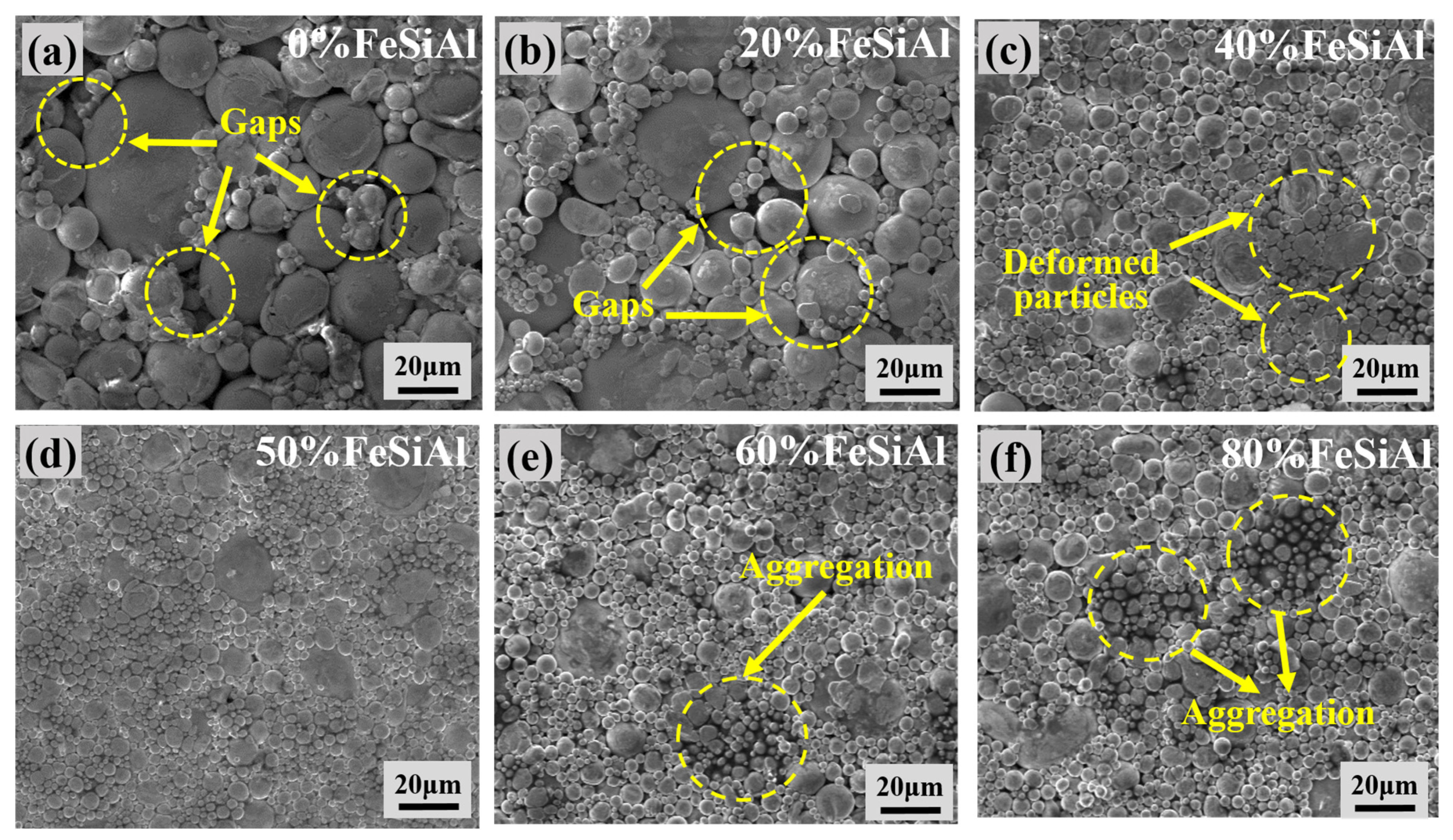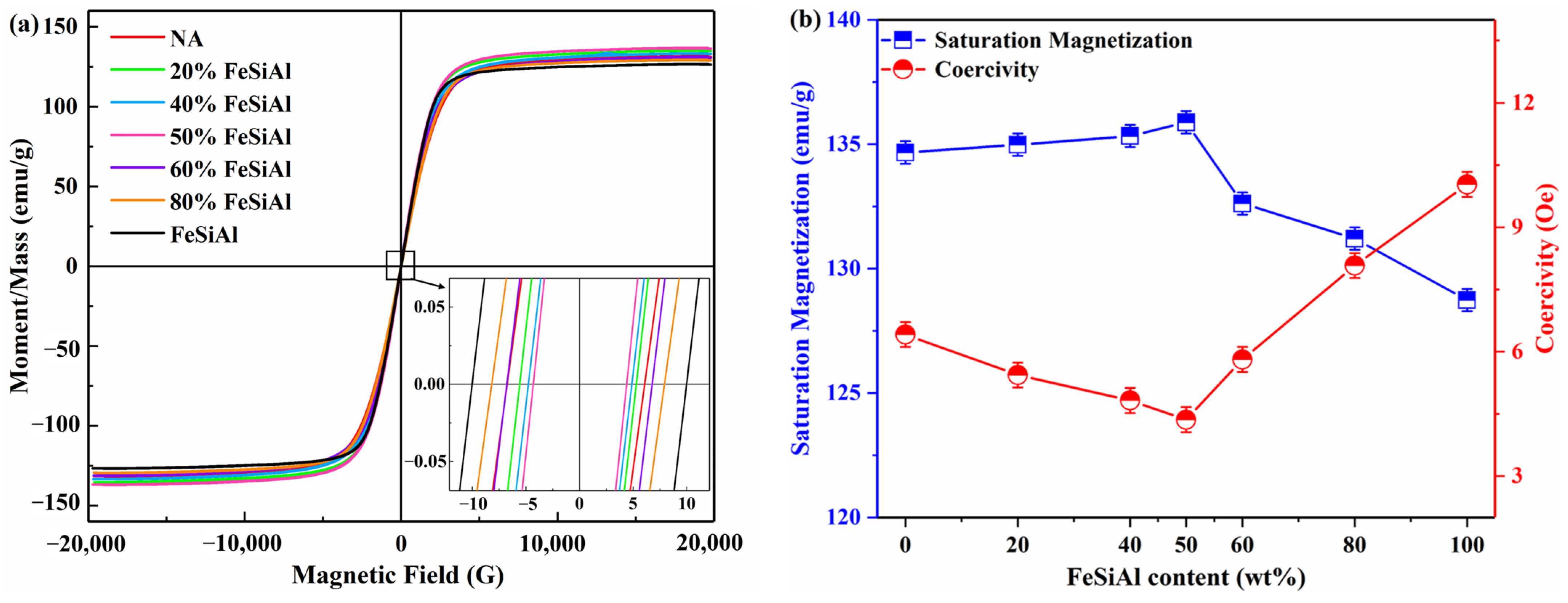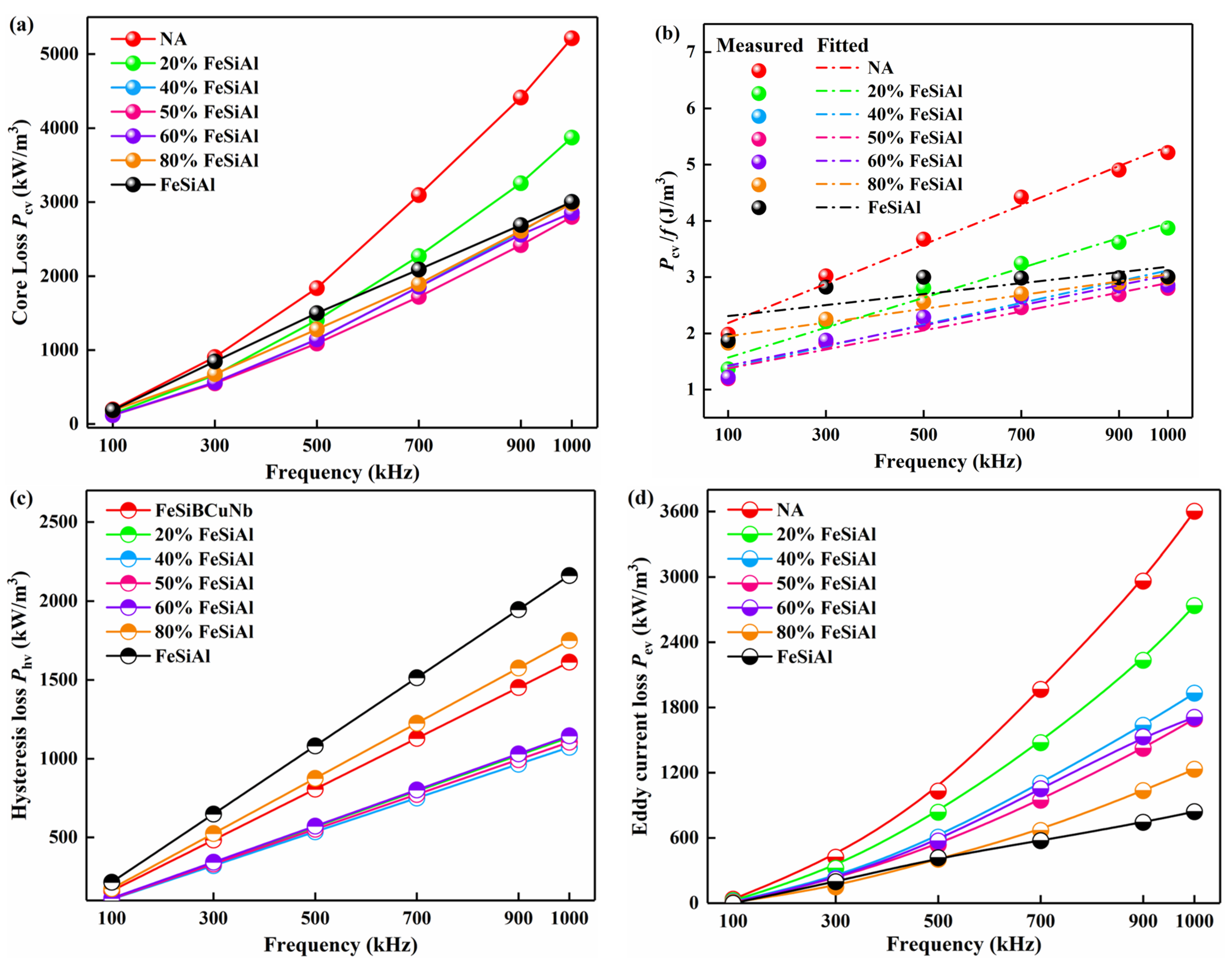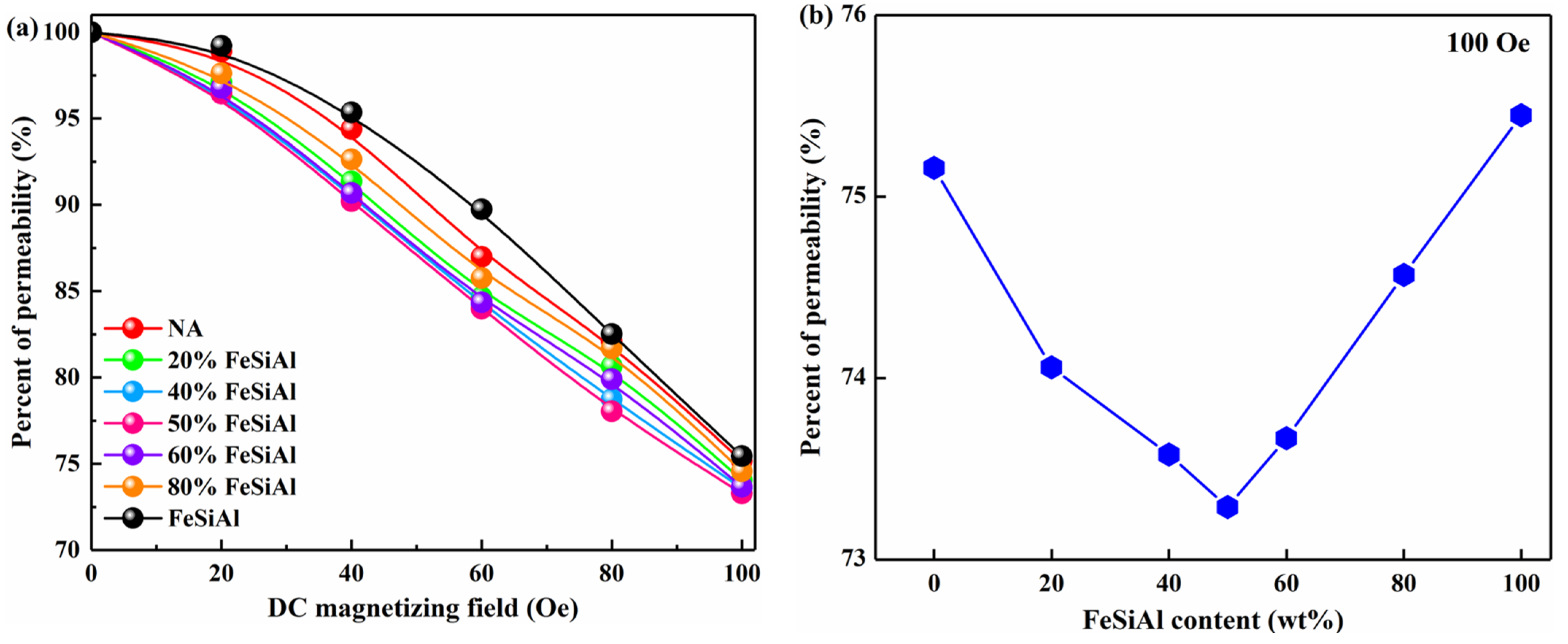Improving the Soft Magnetic Characteristics of Nanocrystalline Soft Magnetic Composites Through the Incorporation of Ultrafine FeSiAl Powders
Abstract
:1. Introduction
2. Experimental Details
2.1. Preparation of FeSiBCuNb/FeSiAl NSMCs
2.2. Experimental Materials
3. Results and Discussion
3.1. Characteristics of Raw Powders
3.2. Microstructure of NSMCs
3.3. Saturation Magnetization and Coercivity of NSMCs
3.4. Effective Permeability of NSMCs
3.5. Core Loss of NSMCs
3.6. DC-Bias Performance
4. Conclusions
Author Contributions
Funding
Institutional Review Board Statement
Informed Consent Statement
Data Availability Statement
Conflicts of Interest
References
- Pošković, E.; Franchini, F.; Ferraris, L.; Fracchia, E.; Bidulska, J.; Carosio, F.; Actis Grande, M. Recent advances inmulti-functional coatings for soft magnetic composites. Materials 2021, 14, 6844. [Google Scholar] [CrossRef] [PubMed]
- Zhou, T.; Liu, Y.; Cao, P.; Du, J.; Lin, Z.; Wang, R.; Harris, V.G. Cold Sintered Metal–Ceramic Nanocomposites for High-Frequency Inductors. Adv. Electron. Mater. 2020, 6, 2000868. [Google Scholar] [CrossRef]
- Cheng, H.; Li, X.; Zhang, L.; Shen, F.; Liu, X.; Sun, Y. Ultra-low core loss FeSiAl soft magnetic composites with in-situ double oxidation layers of outer Fe3O4 layer and inner super-thin Al2O3/SiO2 hybrid layer. Ceram. Int. 2023, 49, 26568–26577. [Google Scholar] [CrossRef]
- Dong, Y.; Liu, J.; Wang, P.; Zhao, H.; Pang, J.; Li, X.; Zhang, J. Study of bulk amorphous and nanocrystalline alloys fabricated by high-sphericity Fe84Si7B5C2Cr2 amorphous powders at different spark-plasma-sintering temperatures. Materials 2022, 15, 1106. [Google Scholar] [CrossRef]
- Hsiang, H.I.; Fan, L.F.; Hung, J.J. Phosphoric acid addition effect on the microstructure and magnetic properties of iron-based soft magnetic composites. J. Magn. Magn. Mater. 2018, 447, 1–8. [Google Scholar] [CrossRef]
- Gui, Q.; Zhang, C.; Zhan, T.; Peng, X.; Li, J.; Tao, S.; Ge, H. Improved permeability and core loss of iron-based soft magnetic composites prepared by interface diffusion of nitrogen atoms. Today Commun. 2024, 38, 108161. [Google Scholar] [CrossRef]
- Gheiratmand, T.; Hosseini, H.M. Finemet nanocrystalline soft magnetic alloy: Investigation of glass forming ability, crystallization mechanism, production techniques, magnetic softness and the effect of replacing the main constituents by other elements. J. Magn. Magn. Mater. 2016, 408, 177–192. [Google Scholar] [CrossRef]
- Wang, Y.; Xu, J.; Liu, Y.; Liu, Z. Microstructure evolution, magnetic properties and frequency characteristics of Si-rich FeSiBCuNb soft magnetic alloy induced by annealing treatment. Mater. Charact. 2022, 187, 111830. [Google Scholar] [CrossRef]
- Kim, T.H.; Jee, K.K.; Kim, Y.B.; Byun, D.J.; Han, J.H. High-frequency magnetic properties of soft magnetic cores based on nanocrystalline alloy powder prepared by thermal oxidation. J. Magn. Magn. Mater. 2010, 322, 2423–2427. [Google Scholar] [CrossRef]
- He, J.; Yuan, H.; Nie, M.; Guo, H.; Yu, H.; Liu, Z.; Sun, R. Soft magnetic materials for power inductors: State of art and future development. Mater. Today Electron. 2023, 6, 100066. [Google Scholar] [CrossRef]
- Wang, J.; Guo, Z.; Zeng, Q.; Hang, G.; Xue, Z.; Chen, D.; Liang, Z.; Sun, H. Magnetic properties regulation and loss contribution analysis for Fe-based amorphous powder cores doped with micron-sized FeSi powders. J. Magn. Magn. Mater. 2020, 510, 166931. [Google Scholar] [CrossRef]
- Li, B.; Zheng, Z.; Yu, H.D.; Zeng, D. Improved permeability of Fe based amorphous magnetic powder cores by adding Permalloy. J. Magn. Magn. Mater. 2017, 438, 138–143. [Google Scholar] [CrossRef]
- Zhang, Y.; Chi, Q.; Chang, L.; Dong, Y.; Cai, P.; Pan, Y.; Gong, M.; Huang, J.; Li, J.; He, A.; et al. Novel Fe-based amorphous compound powder cores with enhanced DC bias performance by adding FeCo alloy powder. J. Magn. Magn. Mater. 2020, 507, 166840. [Google Scholar] [CrossRef]
- Chen, Z.; Liu, X.; Kan, X.; Wang, Z.; Zhu, R.; Yang, W.; Rehman, K.M.U. Improved soft magnetic properties of Fe83.5Si7.5B5Cr4 amorphous nanocrystalline powder cores by adding Permalloy. J. Mater. Sci. Mater. Electron. 2018, 29, 19316–19321. [Google Scholar] [CrossRef]
- Tian, M.; Xu, J.; Yang, S.; Wang, J.; Yang, T.; Li, G.; Liu, X. Effects of heat treatment and compaction pressure on the microstructure and magnetic properties of core-shell structured FeSiBNbCu/SiO2 soft magnetic composites. J. Alloys Compd. 2022, 923, 166394. [Google Scholar] [CrossRef]
- Zhang, C.; Tao, P.; Zhu, K.; Chen, Y.; Zhang, W.; Yang, Y. Study of Novel Fe-Based Amorphous/Nanocrystalline Soft Magnetic Powder Cores with NiCuZnFe2O4 Coating Layer. J. Supercond. Nov. Magn. 2021, 34, 2389–2396. [Google Scholar] [CrossRef]
- Wang, B.; Zhang, Z.; Shen, J.; Tian, Y.; Wang, B.; Cai, L.; Liu, L.; Yu, Y.; Wang, G. Mechanism of adding carbonyl iron powder to enhance the magnetic properties of Fe-Si-B-Cu-Nb nanocrystalline soft magnetic composites. J. Alloys Compd. 2024, 972, 172812. [Google Scholar] [CrossRef]
- Song, Y.; Zhou, S.; Zhang, Z.; Zhang, R.; Li, X.; Jing, X. Improvement for soft magnetic properties of FeSiBCuNb nanocrystalline powder cores by adding FeNi powder. J. Non-Cryst. Solids 2024, 646, 123260. [Google Scholar] [CrossRef]
- Wang, J.; Li, G.; He, Y.; Xu, J.; Qiu, Z.; Zheng, Z.; Zeng, D. Improvement in core losses for FeSiAl soft magnetic composites induced by powder annealing treatment. J. Mater. Res. Technol. 2023, 24, 2500–2513. [Google Scholar] [CrossRef]
- Peng, X.; Zhang, A.; Li, J.; Yu, S.; Chang, J.; Ge, M.; Fang, J. Design and fabrication of Fe–Si–Al soft magnetic composites by controlling orientation of particles in a magnetic field: Anisotropy of structures, electrical and magnetic properties. J. Mater. Sci. 2019, 54, 8719–8726. [Google Scholar] [CrossRef]
- Liu, J.; Dong, Y.; Zhu, Z.; Zhao, H.; Pang, J.; Wang, P.; Zhang, J. Fe-based amorphous magnetic powder cores with low core loss fabricated by novel gas–water combined atomization powders. Materials 2022, 15, 6296. [Google Scholar] [CrossRef] [PubMed]
- Yabu, N.; Sugimura, K.; Sonehara, M.; Sato, T. Fabrication and evaluation of composite magnetic core using iron-based amorphous alloy powder with different particle size distributions. IEEE. Trans. Magn. 2018, 54, 2801605. [Google Scholar] [CrossRef]
- Zhu, Z.; Liu, J.; Zhao, H.; Pang, J.; Wang, P.; Zhang, J. Study of the soft magnetic properties of FeSiAl magnetic powder cores by compounding with different content of epoxy resin. Materials 2023, 16, 1270. [Google Scholar] [CrossRef] [PubMed]
- Huang, M.; Wu, C.; Jiang, Y.; Yan, M. Evolution of phosphate coatings during high-temperature annealing and its influence on the Fe and FeSiAl soft magnetic composites. J. Alloys Compd. 2015, 644, 124–130. [Google Scholar] [CrossRef]
- Zhang, L.; Wu, Y.; Dong, Y.; Jia, X.; He, A.; Li, J.; Wang, W.; Shen, B. Fabrication of FeSiBPCNbCu nanocrystalline soft magnetic powders with high saturation magnetization and low core loss. J. Mater. Sci. 2024, 59, 8784–8795. [Google Scholar] [CrossRef]
- Xia, C.; Peng, Y.; Yi, X.; Yao, Z.; Zhu, Y.; Hu, G. Improved magnetic properties of FeSiCr amorphous soft magnetic composites by adding carbonyl iron powder. J. Non-Cryst. Solids 2021, 559, 120673. [Google Scholar] [CrossRef]
- Shi, G.; Li, M.; Wang, H.; Zang, J.; Yin, G.; Wang, M.; Wang, L. Effect of the shape and content for added iron powder on properties of nanocrystalline soft magnetic composites. Mater. Today Commun. 2024, 39, 108888. [Google Scholar] [CrossRef]
- Bertotti, G. General properties of power losses in soft ferromagnetic materials. IEEE Trans. Magn. 1988, 24, 621–630. [Google Scholar] [CrossRef]
- Guo, Z.; Wang, J.; Chen, W.; Chen, D.; Sun, H.; Xue, Z.; Wang, C. Crystal-like microstructural Finemet/FeSi compound powder core with excellent soft magnetic properties and its loss separation analysis. Mater. Des. 2020, 192, 108769. [Google Scholar] [CrossRef]
- Périgo, E.A.; Weidenfeller, B.; Kollár, P.; Füzer, J. Past, present, and future of soft magnetic composites. Appl. Phys. Rev. 2018, 5, 031301. [Google Scholar] [CrossRef]
- Dobák, S.; Füzer, J.; Kollár, P.; Fáberová, M.; Bureš, R. Interplay of domain walls and magnetization rotation on dynamic magnetization process in iron/polymer–matrix soft magnetic composites. J. Magn. Magn. Mater. 2017, 426, 320–327. [Google Scholar] [CrossRef]
- Talaat, A.; Greve, D.Q.; Suraj, M.V.; Ohodnicki, R.R. Electromagnetic assisted thermal processing of amorphous and nanocrystalline soft magnetic alloys: Fundamentals and advance. J. Alloys Compd. 2021, 854, 156480. [Google Scholar] [CrossRef]
- Kim, H.R.; Jang, M.S.; Nam, Y.G.; Kim, Y.S.; Yang, S.S.; Kim, Y.J. Enhanced permeability of Fe-based amorphous powder cores realized through selective incorporation of carbonyl iron powders at inter-particle voids. Metals 2021, 11, 1220. [Google Scholar] [CrossRef]
- Li, X.; Dong, Y.; Liu, X.; Wu, S.; Zhao, R.; Wu, H.; Wang, X. Structure evolution of Fe-based nanocrystalline soft magnetic powder cores with excellent properties. Mater. Sci. Eng. B 2022, 285, 115965. [Google Scholar] [CrossRef]
- Li, G.; Shi, G.; Miao, H.; Liu, D.; Li, Z.; Wang, M.; Wang, L. Effects of the gas-atomization pressure and annealing temperature on the microstructure and performance of FeSiBCuNb nanocrystalline soft magnetic composites. Materials 2023, 16, 1284. [Google Scholar] [CrossRef] [PubMed]
- Shi, G.; Wang, M.; Miao, H.; Li, G.; Li, B.; Zang, J.; Yin, G.; Wang, L.; Li, Z. Optimization of electromagnetic properties for soft magnetic powder cores prepared by gas-atomized FeSiBCuNb powders with continuously distributed the phase structures. Mater. Sci. Eng. B 2023, 298, 116852. [Google Scholar] [CrossRef]
- Zhang, C.; Liu, X.; Feng, S.; Kan, X.; Yang, Y.; Zhu, Y.; Zhang, Z. High frequency electromagnetic properties of Fe73.5Si13.5B9Nb3Cu1/carbonyl Fe composites. J. Mater. Sci. Mater. Electron. 2023, 34, 658. [Google Scholar] [CrossRef]
- Zhang, Z.; Liu, X.; Jiang, Y.; Xing, B.; Li, W.; Jing, X.; Ge, P.; Zhang, R.; Xu, F. Enhanced high-frequency electromagnetic properties of Fe-based amorphous soft magnetic composites by adding carbonyl iron powder. J. Mater. Sci Mater. Electron. 2024, 35, 411. [Google Scholar] [CrossRef]
- Wang, P.; Zhu, Z.; Liu, J.; Zhao, H.; Pang, J.; Zhang, J. Soft magnetic properties regulation of FeSiBC amorphous powders/CIP magnetic powder core with single and double-layer core–shell structure. J. Magn. Magn. Mater. 2023, 578, 170809. [Google Scholar] [CrossRef]







| Samples | μe 100 kHz | Pcv (kW/m3) | DC Bias (%)100Oe | References | |
|---|---|---|---|---|---|
| 50 mT/ 100 kHz | 20 mT/ 1000 kHz | ||||
| FeSiBCuNb | 31 | 183.4 | 765.3 | 75.2 | This work |
| FeSiBCuNb/50 wt.% FeSiAl | 48.7 | 119.4 | 416.6 | 73.3 | This work |
| FeSiBPCNbCu | 51.5 | 107 | / | 52 | [25] |
| FeSiBCuNb | 49.1 | 135.6 | / | 60.3 | [34] |
| FeSiBCuNb | 33.32 | / | / | 85 | [35] |
| FeSiBCuNb | 29.38 | / | 786 | 67.28 | [36] |
| FeSiBCuNb/CIP | 74.8 | / | 607 | / | [37] |
| FeSiBCuNb/CIP | 35.3 | 281.8 | 915.2 | / | [17] |
| FeSiBCuNb/CIP | / | / | 748.4 | >94 | [27] |
| FeSiBC/CIP | 38.6 | / | 691 | 85 | [38] |
| FeSiBC/CIP | 31 | / | 762.66 | 81.76 | [39] |
| FeSiBC/15% FeNi | 45.82 | / | / | / | [14] |
Disclaimer/Publisher’s Note: The statements, opinions and data contained in all publications are solely those of the individual author(s) and contributor(s) and not of MDPI and/or the editor(s). MDPI and/or the editor(s) disclaim responsibility for any injury to people or property resulting from any ideas, methods, instructions or products referred to in the content. |
© 2025 by the authors. Licensee MDPI, Basel, Switzerland. This article is an open access article distributed under the terms and conditions of the Creative Commons Attribution (CC BY) license (https://creativecommons.org/licenses/by/4.0/).
Share and Cite
Song, Y.; Zhang, Z.; Zhou, S.; Zhang, R.; Yu, H.; Li, X. Improving the Soft Magnetic Characteristics of Nanocrystalline Soft Magnetic Composites Through the Incorporation of Ultrafine FeSiAl Powders. Magnetochemistry 2025, 11, 25. https://doi.org/10.3390/magnetochemistry11040025
Song Y, Zhang Z, Zhou S, Zhang R, Yu H, Li X. Improving the Soft Magnetic Characteristics of Nanocrystalline Soft Magnetic Composites Through the Incorporation of Ultrafine FeSiAl Powders. Magnetochemistry. 2025; 11(4):25. https://doi.org/10.3390/magnetochemistry11040025
Chicago/Turabian StyleSong, Yanyan, Zhi Zhang, Shaoxiong Zhou, Ruibiao Zhang, Haichen Yu, and Xiantao Li. 2025. "Improving the Soft Magnetic Characteristics of Nanocrystalline Soft Magnetic Composites Through the Incorporation of Ultrafine FeSiAl Powders" Magnetochemistry 11, no. 4: 25. https://doi.org/10.3390/magnetochemistry11040025
APA StyleSong, Y., Zhang, Z., Zhou, S., Zhang, R., Yu, H., & Li, X. (2025). Improving the Soft Magnetic Characteristics of Nanocrystalline Soft Magnetic Composites Through the Incorporation of Ultrafine FeSiAl Powders. Magnetochemistry, 11(4), 25. https://doi.org/10.3390/magnetochemistry11040025






